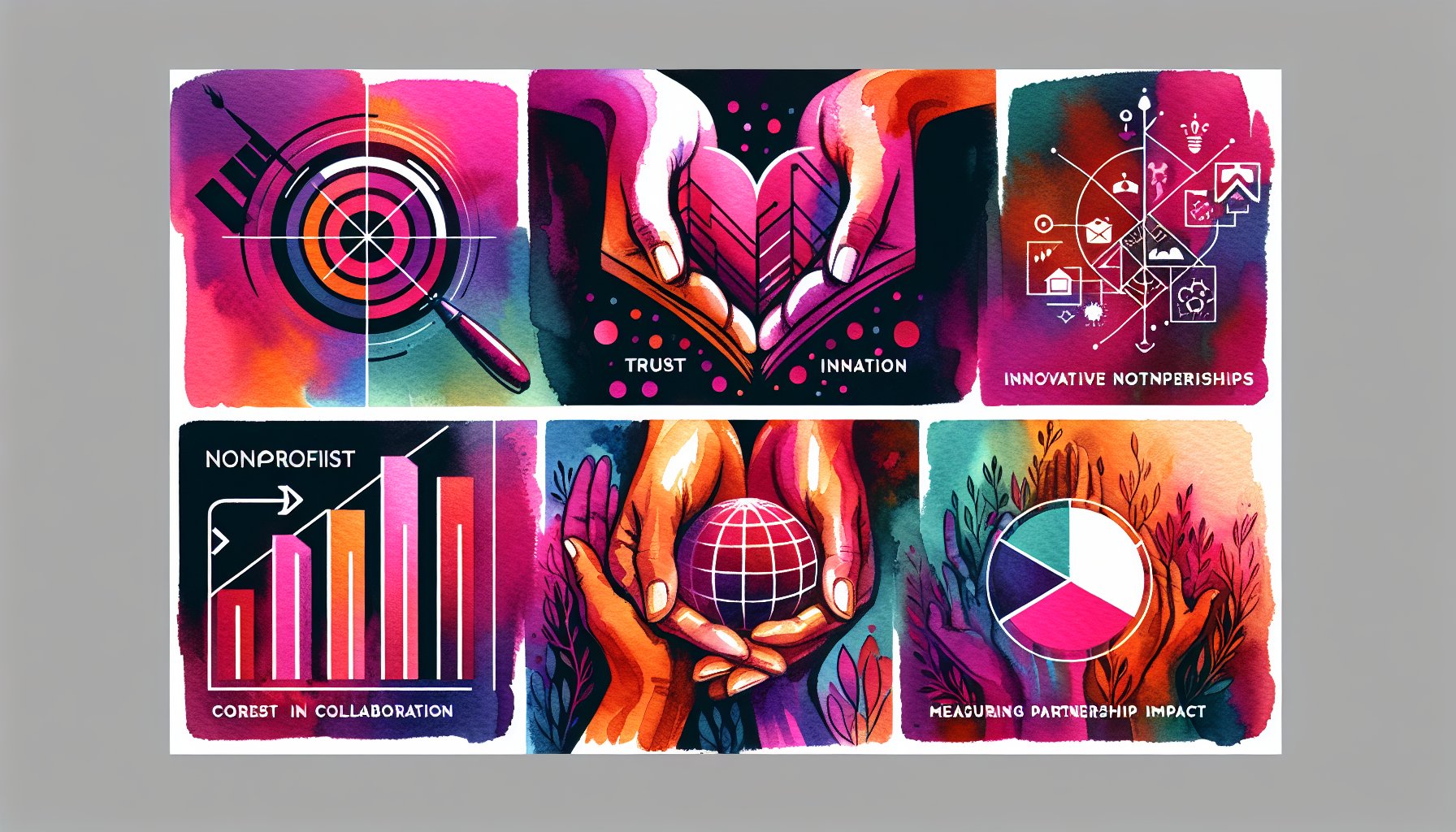Strengthening Partnerships
How to Strengthen Partnerships: Tips for Nonprofit Organizations
Discover effective strategies for nonprofits to strengthen partnerships. Learn how to build trust, align goals, and foster collaboration for transformative community impact. Explore innovative tips for enhancing your nonprofit's mission through powerful partnerships.
Oct 20, 2025
7 min read

Building Bridges: Innovative Strategies for Strengthening Nonprofit Partnerships
In a world often divided by myriad interests and challenges, the power of partnerships emerges as a beacon of potential within the nonprofit sector. Nonprofits aiming to amplify their impact must realize that effective collaboration transcends mere joint initiatives; it thrives on authentic relationships forged by trust, shared vision, and mutual benefit. The most successful organizations cultivate connections that not only enhance their missions but also foster community resilience.
TLDR; Nonprofit partnerships thrive when built on trust, shared vision, and embracing innovative strategies. Through open communication, strategic alignment, and a culture of co-creation, nonprofits can forge lasting relationships that make a transformative community impact.
The Partnership Paradigm Shift: From Transactional to Transformational
Now, let's shake things up a bit, nonprofit partnerships aren't just about exchanging funds for services anymore. They're evolving into dynamic, transformational relationships. Picture those community-based organizations teaming up with healthcare providers; it's not just about pooling resources to tackle health disparities. It's about creating a ripple effect of positive change. So, how do you shift from transactional to transformational? Focus on shared goals, not just gains, and embrace the art of collaboration over the mere act of exchanging resources.
For instance, consider how the Pew Research Center has championed evidence-based strategies to bring together diverse interests toward impactful solutions. They're not just handing out funds; they're creating platforms for collective action and societal change. When nonprofits embrace this shift, they don’t just receive financial support, they tap into a wealth of knowledge that can elevate their initiatives.
Unpacking the Trust Factor: The Cornerstone of Lasting Collaborations
Trust, as it turns out, is the glue that holds the nonprofit partnership universe together. It's not just a fluffy abstract concept, it's the tangible asset steering collaborations toward transformative outcomes. Take community health organizations partnering with local governments to improve health outcomes for low-income communities. The success of such collaborations often hinges not only on a shared mission but on steadfast trust built through open dialogue and transparent strategies. Pew Research Center exemplifies this, fostering data-driven partnerships that align on evidence and mutual interests.
Achieving this level of trust isn't a walk in the park. It requires diligent relationship-building, consistent communication, and, yes, a fair share of listening. Ensuring all voices are heard, especially when diverse interests converge, is key. Think of it as building a foundation that allows you to lean into challenging conversations and tackle the nuances of collaboration with grace.
The Art of Alignment: Finding Your Perfect Partner Match
In the intriguing world of nonprofit partnerships, alignment is more than a buzzword; it's the essence of creating a synergistic relationship. It's about finding that perfect partner whose mission harmonizes beautifully with yours. Picture it as weaving complementary threads together to form a robust tapestry of community engagement and social change.
Before you rush into any partnership, do your homework. Are your potential partners' missions and values aligned with yours? Are their past projects and community engagements resonating with your organization's goals? Take a page from the Pew Research Center's playbook, use their rigorous data-driven analysis to vet potential partners. When both parties understand how their unique strengths complement each other, magic happens. But remember, this isn't a "one-size-fits-all" deal. Partnerships should be as adaptable as they are impactful.
The Communication Compass: Your Guide to Navigating Partnerships
Venturing into the partnership landscape can feel like navigating a dense forest, easy to get lost without the right tools. Enter effective communication, your trusty compass. It's more than sending messages; it's about creating meaningful connections. Imagine a nonprofit focused on environmental conservation joining forces with a corporate sponsor committed to sustainability. The potential is immense, but without clear communication, they might end up at odds.
The secret? Regular check-ins and updates. Communication isn't just about frequency; it's about the quality of dialogue. Active listening and adapting based on partner feedback are crucial. Use data-driven insights to inform strategies, ensuring your messaging evolves alongside the partnership. When done right, this compass guides you through the complexities, leading to impactful collaboration.
Beyond the Bottom Line: Measuring Success with Impact
Let's talk success metrics, not the kind with dollar signs, but those that truly measure a partnership's impact. It's not just about financial gains; it's about qualitative and quantitative metrics that reflect the partnership's contribution to the community. Think tangible changes in health indicators or educational outcomes, not just funds exchanged.
Trust, an elusive yet critical element, can be measured through regular communication and feedback. Pew's collaborative frameworks emphasize trust as a quantifiable entity, ensuring partners confidently commit to shared objectives. Aligning visions and revisiting shared goals keep partnerships from losing their transformative edge. Remember, it's about capturing the qualitative narratives that highlight the real-world impact of joint efforts.
Cultivating a Culture of Co-Creation: Beyond Traditional Philanthropy
To truly engage stakeholders, nonprofits must embrace co-creation. It's not about just inviting contributions; it's about transforming relationships into dynamic collaborations where all voices matter. Consider Pew Charitable Trusts as a model of co-creation's potential. By synthesizing diverse viewpoints, Pew doesn't just disseminate information; they engage stakeholders in shaping policy and community initiatives.
Co-creation means engaging community members in project design and involving local businesses in resource allocation. Challenges may arise, but transparency about decision-making and adaptability ensure stakeholders see their input reflected in outcomes. When done right, co-creation elevates partnerships from transactional to transformational, resulting in initiatives that empower communities.
The Power of Storytelling: Amplifying Partnership Narratives
In nonprofit partnerships, storytelling is indispensable. It's not just about sharing statistics; it's about humanizing collaborations. When organizations like Pew articulate narratives through research and storytelling, they bridge gaps between data-driven insights and human experiences. And when nonprofits craft their narratives like Pew, they allow stakeholders to visualize real-world implications, fostering engagement and support.
Storytelling spotlights unique strengths and values, showcasing the synergy between partners. However, clarity is key. Avoid the pitfall of excessive data, distill stories to their core messages, letting the human element shine. By telling stories with passion, authenticity, and clarity, nonprofits amplify their missions, inspire communities, and forge lasting relationships.
Resilience in Collaboration: Adapting During Crisis
In an unpredictable world, resilience in collaboration is vital. When crises hit, nonprofit partnerships must endure challenges and emerge stronger. The COVID-19 pandemic, for instance, pushed organizations to innovate rapidly. Resilience comes from open communication, shared resources, and a commitment to adapting strategies. Flexible partnerships can create win-win scenarios even in dire circumstances.
Challenges demand reevaluating siloed approaches. Nonprofits that engage in open communication and innovative solutions build a robust network to weather future storms. By embracing flexibility and change, they set a precedent for others, proving that even in adversity, partnerships can be powerful engines for social good.
Beyond the Horizon: Future-Proofing Nonprofit Partnerships
As nonprofit partnerships evolve, future-proofing becomes paramount. It's about anticipating change and sustaining mutual benefits. Trust, transparency, and shared vision, fundamentals at Proforma Color Press, are essential. Data-driven decision-making, flexible funding models, and financial strategies enhance partnership resilience. By nurturing these aspects, nonprofits can thrive amid uncertainty, ensuring their impact continues to benefit communities.
The Circle of Influence: Creating a Partnership Ecosystem
In the nonprofit sphere, a "Circle of Influence" represents more than partnerships; it's about forging a robust ecosystem. It amplifies each participant's impact, creating a ripple effect across sectors. Trust, open communication, and shared goals are the cornerstones of this ecosystem. When nonprofits align objectives and continuously nurture relationships, they cultivate a Circle of Influence that fortifies their missions and leads to a more impactful, interconnected community.
In the end, nonprofit partnerships are a dynamic blend of creativity, trust, and adaptability. By embracing these elements and weaving them into the fabric of their collaborations, organizations not only amplify their missions but inspire transformative change in the communities they serve.
Need Help?
Check out these related products that can help:



